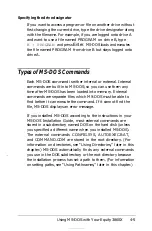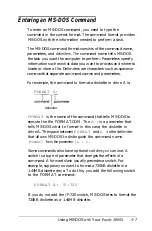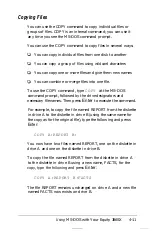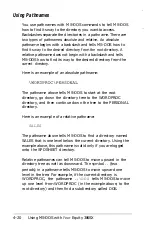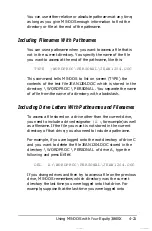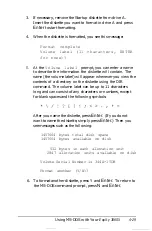
This directory tree lets you separate business word processing
files from personal word processing files, and sales spreadsheets
from spreadsheet files used for financial projections.
Your directory structure may be as simple as this example or
much more complex. Organize your disk(s) to suit your needs.
As your needs change, you can modify the structure by deleting
old directories and creating new ones.
Here are some additional points about directories:
Name subdirectories the same way you name files. The
name can include up to eight characters (letters or
numbers), and you can add an extension of up to three
characters.
The root directory does not have a name. It is identified by
the backslash character: \.
The total number of files and subdirectories in the root
directory must not exceed 512 on a hard disk or 112 on a
1.44MB diskette.
All directories other than the root directory can have any
number of files and subdirectories.
Like hard disks, diskettes have root directories, and you can
create subdirectories on diskettes the same way as you create
subdirectories on a hard disk.
The following sections describe how to create, use, and delete
directories.
Note
The MS-DOS Shell program provides an easy way to see and
organize your directories. See “The MS-DOS Shell Program,”
later in this chapter, and your MS-DOS Shell User’s Guide.
4-18
Using MS-DOS with
Your
Equity 386SX
Summary of Contents for Equity 386SX PLUS
Page 1: ...m u cl3 0 z E 5 J I 1 al y 8 c 7 5 w ii u l X ...
Page 4: ...EPSON E Q U I T Y 3 8 6 S X User s Guide Y19299100100 ...
Page 20: ...6 Introduction ...
Page 38: ...1 18 Setting Up Your System ...
Page 69: ......
Page 70: ...2 32 Running the Setup Program ...
Page 96: ... 7 R _ ri h 14 3 26 Using the Equity 386SX ...
Page 168: ...5 26 dling Options ...
Page 192: ...B 4 Power on Diagnostics ...
Page 232: ...C 40 Performing System Diagnostics ...
Page 246: ... D 14 Physically Formatting a Hard Disk ...
Page 250: ...E 4 Hard Disk Drive Types ...
Page 282: ...8 I n d e x ...
Page 284: ......


